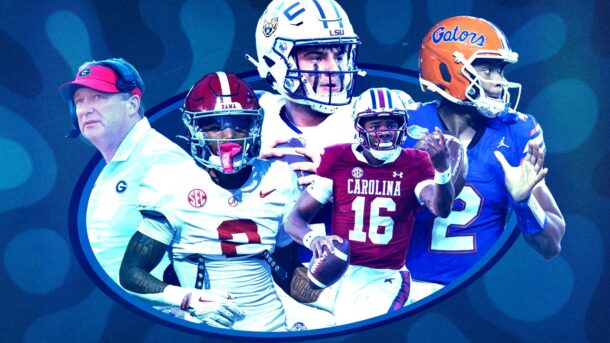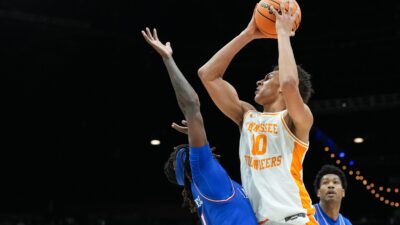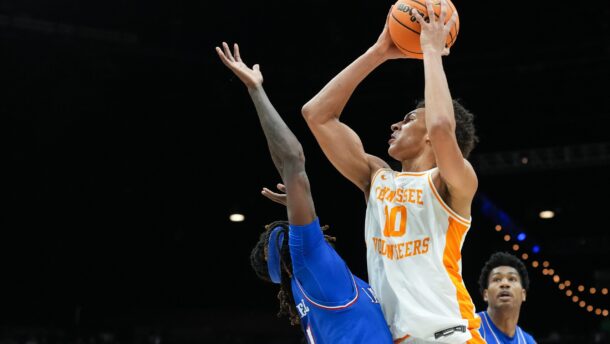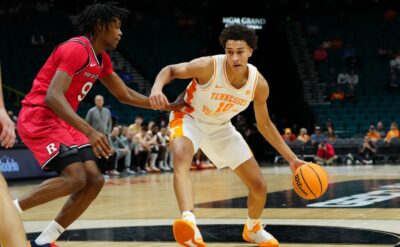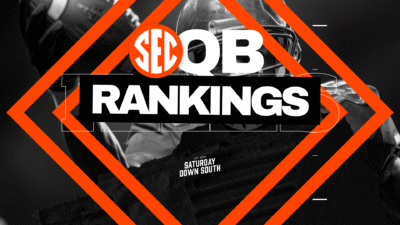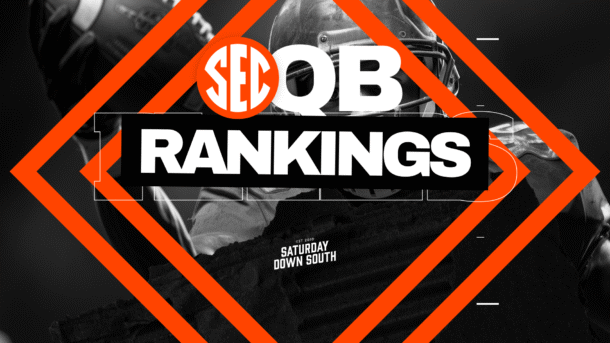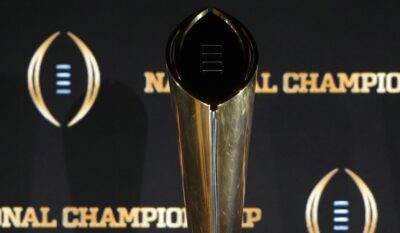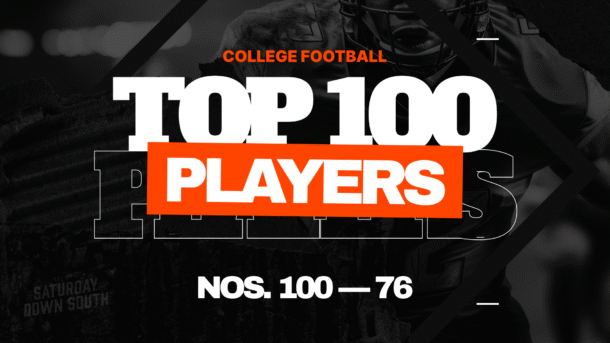
SDS’ Top 100: Ranking the best college football players in 2025 (Nos. 100-76)
By Matt Hinton
Published:
The 2025 college football season will feature thousands of players on 136 FBS rosters. Here is Saturday Down South’s annual countdown of the best of the best. TODAY: Part 1 of 4, ranking players No. 100 through No. 76.
— — —
100. Julian Sayin | QB, Ohio State
99. Ty Simpson | QB, Alabama
98. Dante Moore | QB, Oregon
Let’s go ahead and get this part out of the way. Alert readers will note that Sayin has yet to take a meaningful college snap, and neither Moore nor Simpson has taken enough to draw any conclusions. Acknowledged: All three are wild cards. They’re also elite prospects inheriting three of the sport’s most decorated, high-profile positions, with minimum patience for growing pains. Either the starting quarterback at Ohio State/Alabama/Oregon is residing a heck of a lot higher on this list by December, or his time is probably up.
97. Makai Lemon | WR, USC
USC’s offense underachieved in 2024, coming in 51st nationally in scoring despite the usual surplus of blue-chip talent. If there was a silver lining, it was Lemon, a former top-100 recruit who emerged right on schedule. Working almost exclusively from the slot, he led the Trojans in receptions (52), yards (764) and explosive plays, accounting for a dozen gains of 20+ yards; he was also a dynamic presence on kickoff returns, tacking on another 85 yards per game after assuming that role at midseason. An exodus from last year’s rotation means his opportunities should only go up.
96. Rayshaun Benny | DL, Michigan
Four years is a long time to toil as a backup, in the portal era or any other era. In Benny’s case, though, it was par for the course: All four of the guys who started ahead of him in that span – Mazi Smith, Kris Jenkins, Mason Graham and Kenneth Grant – were All-Big Ten types who went on to be top-50 NFL Draft picks. Finally, it’s the understudy’s turn. At 6-4, 296 pounds, Benny is yet another next-level specimen with some inside-out flexibility and respectable production for a role player. If he takes the next step in his lone season as a starter, there’s no reason he can’t extend the draft streak.
95. Trey White | Edge, San Diego State
White is a novelty these days: A bona fide dude at the Group of 5 level who opted to stay put rather than cash in in a power conference. A marginal, undersized recruit out of high school, he beefed considerably in his first 2 years at SDSU and came out of nowhere in 2024 to lead the Mountain West in tackles for loss (19) and sacks (12.5). It’s worth keeping in mind that a) that kind of stat line is hard to replicate in consecutive seasons; and b) the vast majority of White’s sack/TFL output came in a ferocious 4-game stretch in September and October, before tailing off over the course of a 6-game losing streak to close the season. Still, for a rising star with 2 years of eligibility remaining, the Aztecs hope his breakout was only a glimpse of the finished product.
94. Isaiah World | OT, Oregon
World is aptly named in the sense that he may soon be as big as a planet. His last school, Nevada, most recently listed him at 6-8, 309 – a full 40 pounds heavier than when he arrived on campus, on a frame capable of carrying another 40 at the next level. Although still regarded as a project, his rare combination of size, experience (35 career starts in Reno), and room for literal growth made World the most sought-after OL on the transfer market, where he almost certainly commanded seven figures to fill Oregon’s most urgent vacancy at left tackle. If the transition to the Big Ten goes according to plan, he could easily follow the guy he’s replacing on the blind side, Josh Conerly Jr., as a first-round pick.
93. Jack Endries | TE, Texas
Endries is 1of only 2 entries in this year’s Top 100 who began their careers as walk-ons – both of whom, coincidentally, wear burnt orange. (We’ll check in on the other in Part 2.) He was a late portal addition for Texas, arriving over the summer from Cal, where he quietly established himself over the past two years as exactly the kind of steady, sure-handed target the Longhorns were in the market for following the departure of the steady, sure-handed Gunnar Helm. Per PFF, Endries’ 91.8% catch rate in 2024 led the nation among receivers with at least 30 targets. And while he may not be the most scintillating specimen (6-4, 240), don’t sleep on his open-field speed after the catch, either.
92. Jaydn Ott | RB, Oklahoma
Another summer defector from Berkeley to the SEC, Ott ranks among the active FBS leaders with 3,333 scrimmage yards and 30 touchdowns to his credit over 3 seasons at Cal. But the jury remains out on which version Oklahoma is getting: The all-purpose threat who looked like a rising star as an underclassman in 2022 and ’23? Or the shadow version whose production plummeted in ’24 while playing through a nagging ankle injury? The Sooners are betting heavily on the former in hopes of he becomes Oklahoma’s next 1,000-yard rusher. At 5-11, 208 pounds, Ott has every-down potential in any league, and as long as he’s at full speed he should have every opportunity to restore his stock along with that of OU’s slumping ground game.
91. Cayden Green | OL, Missouri
Most interior linemen need a year or two in the oven, at least. Green, on the other hand, arrived on campus from suburban Kansas City already looking like a future pro and wasted no time confirming it. In Year 1 at Oklahoma, he was a regular in the Sooners’ starting lineup and a Freshman All-American. In Year 2, he returned to his home state and started every game for Mizzou, holding down the left guard position alongside top-10 draft pick Armand Membou. Across both seasons Green has allowed a single sack and 2 QB hits on more than 700 pass-blocking snaps, per PFF, setting himself up to be the rare guard to go three-and-out on his way to the next level.
90. Tim Keenan III | DT, Alabama
It’s tempting to typecast the 6-2, 326-pound Keenan as a throwback– a “war daddy” who’s wider than he is long, and whose skill set amounts to absorbing double teams in the middle of the line of scrimmage. Beyond his raw size, Keenan was an elite run-stuffer in 2024, boasting the top PFF grade against the run (90.1) of any returning interior DL in a power conference. But he doesn’t play in a bygone era, and he’s not strictly a one-dimensional plodder, as his 33 QB pressures over the past 2 seasons can attest. A little more pass-rushing juice in his final year at Alabama would go a long way toward convincing scouts he’s a full-service, every-down prospect.
89. AJ Haulcy | DB, LSU
Haulcy’s career arc is a case study in portal-era opportunism. An overlooked recruit out of the Houston area, he started out in obscurity at New Mexico. After a breakout freshman campaign in Albuquerque, he transferred home to the University of Houston, where he started every game the past 2 years and earned first-team All-Big 12 in 2024. Now fully established, he made the short but lucrative drive along I-10 East to Baton Rouge, where he enrolled over the summer and immediately projects as one of the top safeties in the SEC. LSU hasn’t had a defensive back drafted in 2 years, a drought by local standards. Haulcy and another big-ticket transfer, cornerback Mansoor Delane from Virginia Tech, are being counted on to get LSU’s NFL Draft pipeline flowing again.
88. Cashius Howell | Edge, Texas A&M
A&M’s d-line was well represented in April’s NFL Draft, with 3 outgoing starters taken in the first 2 rounds. On a snap-by-snap basis, though, nobody on the line was more disruptive than Howell, a former Bowling Green transfer who emerged as arguably the Aggies’ best pass rusher off the bench. Although he was credited with only 4 official sacks, Howell was a regular presence in opposing backfields, generating 34 QB pressures and an elite PFF pass-rushing grade (91.4) that ranked No. 3 in a conference loaded with NFL-ready edge rushers. (For what it’s worth, that was on the heels of a 90.3 pass-rushing grade in 2023 at Bowling Green, making him 1 of only 5 players nationally with 90+ grades each of the past 2 seasons.) He finished on a high note, turning in his best game of the season in his only start, a Las Vegas Bowl loss to USC. Now the established vet of the group, all signs point to a much larger number in the sack column as Howell moves to the top of the rotation and tries to add to Texas A&M’s NFL Draft list.
87. David Bailey | Edge, Texas Tech
A major recruit from a high-profile high school, Bailey could have punched his ticket to pretty much any college in America. He picked Stanford, where – in addition to picking up a bachelor’s degree that says “Stanford” on it – he toiled in vain on a series of morose teams that finished 3-9 in 3 consecutive seasons. While his old school struggles to adapt to the sport’s Wild West era, his new school is going to great lengths to embrace it. Texas Tech offered Bailey a reported $2 million to lure him to Lubbock, making him the headliner of one of the nation’s most ambitious transfer hauls. Sure, take “reported” NIL figures with several grains of salt. But whatever the price tag, any effort that succeeds in juicing the Red Raiders’ anemic pass rush is worth the investment.
86. Austin Romaine | LB, Kansas State
K-State isn’t K-State without its share of under-recruited, overachieving grunts from towns with 4-digit populations. This year, Romaine is the best of the bunch. As a recruit, he didn’t have a single scholarship offer from another power-conference program. Two years later, he’s entrenched as the resident tackle machine, coming off a sophomore campaign in which he recorded 54 stops, 3 forced fumbles and the top overall PFF grade (90.8) of any full-time Big 12 defender. In Year 3, he’s the undisputed leader of a front seven that figures to be the strength of the Wildcats’ College Football Playoff push, where the Wildcats have national championship odds of +10000
85. Drayk Bowen | LB, Notre Dame
One of the few local products on Notre Dame’s roster, Bowen’s star has risen quickly in South Bend, entrenching him atop a crowded LB depth chart for the foreseeable future. He was a mainstay in the Irish’s 2024 College Football Playoff run, starting all 16 games as a true sophomore alongside tenured vet Jack Kiser with nearly identical production. Kiser, who appeared in more career games than any player in school history, went out as a 4th-round NFL Draft pick; Bowen, now one of the Irish’s ranking vets, has a chance to go considerably higher with considerably less mileage.
84. Isaiah Nwokobia | DB, SMU
The Mustangs’ ascent under coach Rhett Lashlee is a transfer portal success story. But their best player is home-grown: Nwokobia attended high school just a few minutes from campus, and was one of the highest-rated members of SMU’s 2021 signing class under then-coach Sonny Dykes. Now, he’s 1 of only 2 remaining holdovers from the roster Lashlee inherited a year later. A versatile presence on the back end, Nwokobia has been a rock over the past 2 seasons, racking up 161 tackles, 7 interceptions and a first-team All-ACC nod in 2024. The only box he has left to check: Going out as SMU’s first consensus All-American (at any position) since 1985.
83. Kamari Ramsey | DB, USC
Ramsey isn’t the first player to cross the rivalry line from UCLA to USC (or vice versa), and barring a literal act of Congress, he won’t be the last. But he might be the first who qualifies as a difference-maker. After starting 11 games as a Bruin in 2023, Ramsey followed defensive coordinator D’Anton Lynn to USC and made an immediate impact in ’24, emerging as arguably the Trojans’ best defender. He led the team in passes defended (6) and forced fumbles (2), while his PFF coverage grade (88.1) ranked No. 2 among Big Ten safeties. The only remaining hurdle to becoming a complete package: Missed tackles. PFF had Ramsey down for 15 whiffs, which he still has 2 years of eligibility to prove was an aberration.
82. Nico Iamaleava | QB, UCLA
Iamaleava is a gifted young quarterback with more potential than production, which depending on your point of view could be code for “rising star” or “overrated.” (For what it’s worth, Vegas can’t quite decide. In January, Iamaleava had solid Heisman Trophy odds; as opening week approaches, not so much.) At Tennessee, he was a little bit of both: On one hand, a franchise-caliber talent who presided over 10 wins, a come-from-behind triumph over Alabama, and a Playoff berth in his first season as a starter; on the other, a work in progress whose output never came close to fulfilling the hype. Despite flashes of his blue-chip arm, Iamaleava failed to join the SEC’s list of 3,000-yard passers; he threw for 2,616 yards. He also finished in the bottom half of the SEC in yards per attempt, pass efficiency, QBR and EPA, and was routinely overshadowed by Tennessee’s defense and ground game. In the end, the best Vols fans could say in the wake of a first-round Playoff wipeout at Ohio State was that the best is yet to come.
If that turns out to be the case, though, it’s going to come somewhere else. Waiting patiently for Iamaleava’s talent to come to fruition is one thing; paying extra for the privilege is another. Tennessee predictably balked at his demand for a raise on top of the reported $2.4 million he was set to make this year in NIL deals (again, take all NIL figures as an approximation), effectively showing the most touted QB prospect in Knoxville since Peyton Manning the door in the middle of the offseason. Instead, Iamaleava will embark on what might be a make-or-break season for his future back home in L.A., where the Bruins are desperate for any semblance of a spark after finishing 126th nationally in scoring offense. Under the right circumstances, the sky is still the the limit. Under the actual circumstances, TBD.
81. AJ Harris | CB, Penn State
A big-time recruit in Georgia‘s 2023 class, Harris felt lost in the mix at UGA among all the other big-time recruits. After a forgettable freshman year, he opted for a reset at Penn State, where he immediately found his niche on a team that advanced further in the Playoff than his old one. He started 15 of 16 games in the Nittany Lions’ Playoff run, allowing a single touchdown in coverage en route to a third-team all-conference nod from Big Ten coaches – no minor feat for a true sophomore in his first year in the league. Penn State has still never had a DB drafted in the first round, but another leap forward in Year 3 will make Harris a candidate to finally retire that line for good.
80. Aaron Graves | DL, Iowa
You know, I think “Iowa defensive tackle” just about covers this one. A meat-and-potatoes player from a meat-and-potatoes program, Graves is at the end of the typical Hawkeye trajectory from developmental prospect to full-grown hoss. He met his moment in 2024, recording 8 tackles for loss as a first-year starter alongside 5th-round pick Yahya Black – the 4th Iowa d-lineman drafted in as many years. Barring disaster, Graves will make it 5-for-5; the only question is how high he can rise.
79. Dontay Corleone | DT, Cincinnati
This time last year, “The Godfather” wasn’t sure he’d see the field at all in 2024 due to blood clots. Once he was cleared, though, he was his usual, immovable self, anchoring Cincinnati’s 3-man front for the third consecutive season. At 6-1, 325, he’s as close as there is in modern football to a vintage 2-gap nose tackle, combining old-school power with the explosiveness to routinely reset the line of scrimmage in the opposing backfield.
Those highlights are from Corleone’s highest-graded game of the year, per PFF, a 44-41 loss at Texas Tech in late September. (Obviously, the Bearcats’ defense as a whole is a far cry from what it was during their Playoff run a few years back.) His pass-rushing production lagged over the second half of the season, raising some standard big man concerns about his conditioning and durability, especially in the wake of an offseason medical scare. But as long as he can stay on the field, he remains potentially the most disruptive force in the Big 12.
78. Lee Hunter | DT, Texas Tech
Hunter began his career as a blue-chip prospect at Auburn, where he signed on just days before the coach who recruited him, Gus Malzahn, was abruptly canned in December 2020. After a redshirt year on The Plains, he reunited with Malzahn at Central Florida, where he made the most of a relatively anonymous situation. Hunter’s 21 TFLs over the past 2 seasons are the most of any returning interior DL in the country, earning him second-team All-Big 12 honors in 2024. Following Malzahn’s resignation from UCF last December, Hunter was on the move again, this time joining the eight-figure transfer haul in Lubbock for his final year of eligibility. The Red Raiders are all-in on making a serious Playoff push, and if their investment in the trenches pays off they may actually stand a chance.
77. Darius Taylor | RB, Minnesota
The Big Ten ditched divisions, but there’s still no better way to categorize the 6-foot, 215-pound Taylor than as a classic Big Ten West back: Big, durable and right at home in an offense willing to give him all the work he can handle. In 2 years at Minnesota, he has churned out 1,787 yards and 15 touchdowns on 19 carries per game, with an astounding 80% of his 2024 output coming after contact, per PFF. He also led all B1G backs last year with 54 receptions, for good measure. At that rate, adding Taylor’s name to the long list of memorable Gopher workhorses is only a matter of keeping him upright.
76. Denzel Boston | WR, Washington
The 2024 Huskies bore no resemblance to the outfit that played for the national title in ’23, essentially fielding an entirely new lineup. If you squinted, though, it was possible to see in Boston the outline of a talent similar to the guy he replaced, All-American/top-10 pick Rome Odunze. At 6-4, 209, Boston shares Odunze’s imposing frame, and his stat line as a redshirt sophomore (63 catches, 834 yards, 9 TDs) was a rough equivalent of Odunze’s breakout redshirt sophomore campaign in 2022. On film, he’s capable of stretching the field, going up to get it in traffic, and turning short gains into long ones.
One advantage Odunze had that Boston didn’t last year was a next-level quarterback. The new QB1 in 2025, sophomore Demond Williams, impressed in a limited role as a true freshman, but likely isn’t inspiring any visions of Michael Penix Jr. anytime soon. Whether it shows up in the box score or not, a big part of Boston’s job will be making Williams look good as he settles in for the long haul.
– – –
TOMORROW: The countdown continues with Nos. 75 through 51.
Matt Hinton, author of 'Monday Down South' and our resident QB guru, has previously written for Dr. Saturday, CBS and Grantland.
